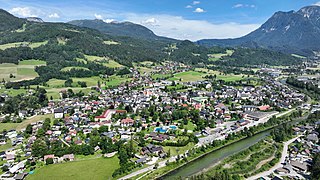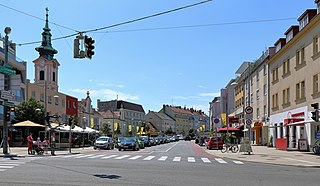
Eisenstadt is a city in Austria, the state capital of Burgenland. It had a recorded population on 29 April 2021 of 15,074.

NicolaAntonio Porpora was an Italian composer and teacher of singing of the Baroque era, whose most famous singing students were the castrati Farinelli and Caffarelli. Other students included composers Matteo Capranica and Joseph Haydn.

Bad Goisern am Hallstättersee is a market town in the Austrian state of Upper Austria in the district of Gmunden. It is part of the Salzkammergut resort area. At the 2005 census Bad Goisern am Hallstättersee had a population of 7,578 inhabitants.

The market town of Bad Fischau-Brunn is an Austrian municipality in the district of Wiener Neustadt-Land in Lower Austria. It is situated some 50 km south of Vienna at the edge of Viennese Basin.

Bruck an der Leitha is a town in the state of Lower Austria of Austria on the border of Burgenland, marked by the Leitha river. In 2018 it had a population of around 8,000.
Rohrau is a village in the state of Lower Austria. The name comes from two German words: Rohr (reed) and Au. South of the village is a riparian forest and a swamp covered with reed.

Hainburg an der Donau is a town located in the Bruck an der Leitha district in the state of Lower Austria of eastern Austria. In 2021 it had a population of about 7,000.

Puchberg am Schneeberg is a town in the south-eastern part of Lower Austria with approximately 2650 inhabitants. It is situated about 80 Kilometres from Vienna. The highest point of Puchberg is the Schneeberg with 2076 m, the highest mountain of Lower Austria.

Bad Ischl is a spa town in Austria. It lies in the southern part of Upper Austria, at the Traun River in the centre of the Salzkammergut region. The town consists of the Katastralgemeinden Ahorn, Bad Ischl, Haiden, Jainzen, Kaltenbach, Lauffen, Lindau, Pfandl, Perneck, Reiterndorf and Rettenbach. It is connected to the village of Strobl by the river Ischl, which drains from the Wolfgangsee, and to the Traunsee, into which the stream empties. It is home to the Kaiservilla, summer residence of Austro-Hungarian monarchs Emperor Franz Joseph I and Empress Elisabeth. In 2024, Bad Ischl will be one of the European Capitals of Culture – the third city in Austria after Graz (2003) and Linz (2009).

Schwechat is a city southeast of Vienna known for the Vienna International Airport and Schwechater beer. The city is home to the refineries of the Austrian national oil company OMV.

Frauenkirchen is an Austrian town in the district of Neusiedl am See, Burgenland.

Tulln an der Donau is a historic town in the Austrian state of Lower Austria, the administrative seat of Tulln District. Because of its abundance of parks and gardens, Tulln is often referred to as Blumenstadt, and "The City of Togetherness" following the initiative of Peter Eisenschenk, Mayor of Tulln.

Bad Hall is a market town in the Steyr-Land district of the Austrian state of Upper Austria. Its name, Bad Hall, means "salt bath," a reference to its long history of baths and spas. It is renowned for its saline springs, strongly impregnated with iodine and bromine. Although the springs have been known since the 8th century, Hall has been noted for them only since 1855, when the springs became the property of the government.

Au am Leithaberge is a town in the district of Bruck an der Leitha in Lower Austria in Austria.

Hof am Leithaberge is a town in the district of Bruck an der Leitha in Lower Austria in Austria.

Trautmannsdorf an der Leitha is a town in the district of Bruck an der Leitha in Lower Austria in Austria.

Angern an der March is a market town in the district of Gänserndorf in the Austrian state of Lower Austria. The municipality consists of the Katastralgemeinden Angern, Grub, Mannersdorf, Ollersdorf and Stillfried.

Guntramsdorf is a town in the district of Mödling in the Austrian state of Lower Austria. As part of the "Industrieviertel", the industrial region in the southeast of Lower Austria, it is well connected to the country capital Vienna. The local rail service Badner Bahn connects Guntramsdorf with the central district of Vienna in the north and popular spa resort destination Baden bei Wien in the south. In the west of the town lies the Vienna Woods, an outlier of the Alpine foothills, featuring recreational forest areas and hiking trails, and the southeast of Guntramsdorf extends into the thermal Vienna Basin.

The Imperial Royal Privileged Austrian State Railway Company, from 1 January 1883 the Privileged Austro-Hungarian State Railway Company was a private railway company in the Austro-Hungarian Empire. Its title was abbreviated to State Railway Company (Staats-Eisenbahn-Gesellschaft) or StEG.


























